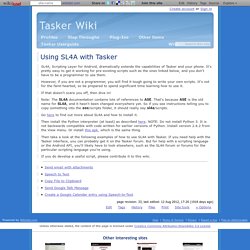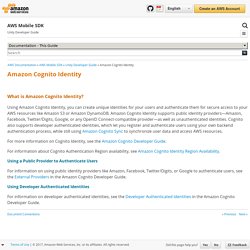

[GUIDE] Tasker. Python for Android: The Scripting Layer (SL4A) The Scripting Layer for Android, SL4A, is an open source application that allows programs written in a range of interpreted languages to run on Android.

It also provides a high level API that allows these programs to interact with the Android device, making it easy to do stuff like accessing sensor data, sending an SMS, rendering user interfaces and so on. It's is really easy to install and it works on any stock Android device, so you don't need to be root or anything like that. Currently, the Scripting Layer supports Python, Perl, Ruby, Lua, BeanShell, JavaScript and Tcl. It also provides access to the Android system shell, which is actually just a minimal Linux shell. You can find out more about the SL4A project from their website. There are a couple of other options for running Python on Android, and some are very good, but none offer the flexibility and features of the Scripting Layer. SL4A is really easy to install. Using SL4A in Python is really simple.
Tasker for Android. Mobile App Cost Calculator. Beginners Guide to Android Tasker. Using SL4A with Tasker. SL4A, Scripting Layer for Android, dramatically extends the capabilities of Tasker and your phone.

It's pretty easy to get it working for pre-existing scripts such as the ones linked below, and you don't have to be a programmer to use them. However, if you are not a programmer, you will find it tough going to write your own scripts. It's not for the faint-hearted, so be prepared to spend significant time learning how to use it. If that doesn't scare you off, then dive in! Note: The SL4A documentation contains lots of references to ASE. Go here to find out more about SL4A and how to install it. Then install the Python interpreter (at least) as described here.
Then take a look at the following examples of how to use SL4A with Tasker. If you do develop a useful script, please contribute it to this wiki. Sl4a/ApiReference.md at wiki · damonkohler/sl4a. Building Apps for TV. Building Apps with Connectivity & the Cloud. Wear. About Android TV. [BOOTLOADER][SAFEBOOT] Ouya Bootmenu (mlq) Ouya Bootmenu development/release thread This is based on the awesome work by Hal9k.
![[BOOTLOADER][SAFEBOOT] Ouya Bootmenu (mlq)](http://cdn.pearltrees.com/s/pic/th/bootloader-safeboot-bootmenu-156653181)
Because of the fact that the Ouya doesn't have recovery accessibility via hardware buttons we need to play safe and utilise chainbooting. This bootmenu resides in the kernel partition and is loaded on every normal bootup. In-depth info in Hal9k's thread here: It presents various choices on every boot: Normal boot - (default) loads bootimage from system partition (/system/boot.img) Alternate boot - loads bootimage from sdcard (/sdcard/altboot.img) Recovery - reboots into recovery (recovery partition) Failsafe - loads built-in failsafe mode Bootloader - Reboots into stock bootloader (for fastboot access - USE WITH CARE) Notes about the failsafe the failsafe mode (which has the bootmenu built-in) will pop up in the following cases: Kotlin and Android. Python-for-android/README.md at master · kuri65536/python-for-android. Cognito Identity - AWS Mobile SDK. Using Amazon Cognito Identity, you can create unique identities for your users and authenticate them for secure access to your AWS resources like Amazon S3 or Amazon DynamoDB.

Amazon Cognito Identity supports public identity providers—Amazon, Facebook, Twitter/Digits, Google, or any OpenID Connect-compatible provider—as well as unauthenticated identities. Cognito also supports developer authenticated identities, which let you register and authenticate users using your own backend authentication process, while still using Amazon Cognito Sync to synchronize user data and access AWS resources. For more information on Cognito Identity, see the Amazon Cognito Developer Guide. For information about Cognito Authentication Region availability, see Amazon Cognito Identity Region Availability. An introduction to Kotlin for Android development. Better Android Development with Kotlin & Gradle. Download Slides Ty will walk you through using Kotlin with Gradle and Android to streamline your workflow for app development, both within the build tool phase and within the application itself.

After a brief overview of Kotlin language, he’ll dive into how it can be used with Gradle to accelerate Android Development with a consistent language through the entire stack. Introduction (0:00) Context switching greatly reduces efficiency and it can cause a lot of frustration for developers. In Android development, we use a mix of languages in the app source and the build tool source. I’m Ty, and I’m an Android developer at Uber, working on our external developer platform. What is Wrong With Java? Why isn’t Java good enough? Java in Android can be quite error prone. Groovy is what’s primarily used in building Gradle.
Documentation.
Space_3276804. 2.

Act normal If you are a high-risk source, avoid saying anything or doing anything after submitting which might promote suspicion. In particular, you should try to stick to your normal routine and behaviour. 3. Remove traces of your submission If you are a high-risk source and the computer you prepared your submission on, or uploaded it from, could subsequently be audited in an investigation, we recommend that you format and dispose of the computer hard drive and any other storage media you used. In particular, hard drives retain data after formatting which may be visible to a digital forensics team and flash media (USB sticks, memory cards and SSD drives) retain data even after a secure erasure.
If you do this and are a high-risk source you should make sure there are no traces of the clean-up, since such traces themselves may draw suspicion. 4. If a legal action is brought against you as a result of your submission, there are organisations that may help you. Systems Development. Android Wear. Designing apps for wearable devices powered by Android Wear is substantially different than designing for phones or tablets: different strengths and weaknesses, different use cases, different ergonomics.

To get started, you should understand the overall vision for the Android Wear experience, and how apps fit into and enhance this experience. We've also provided source files for UI resources that you can use in your own apps in the Downloads section. Downloads UI Toolkit, Flows, and Mocks A new form factor deserves a new UI model. Suggest: The Context Stream The context stream is a vertical list of cards, each showing a useful or timely piece of information.
This UI model ensures that users don’t have to launch many different applications to check for updates; they can simply glance at their stream for a brief update on what’s important to them. Cards in the stream are more than simple notifications. Demand: The Cue Card Other UI Features. Documentation·Cucumber. Calaba.sh - Automated Acceptance Testing for iOS and Android Apps. Software.intel.